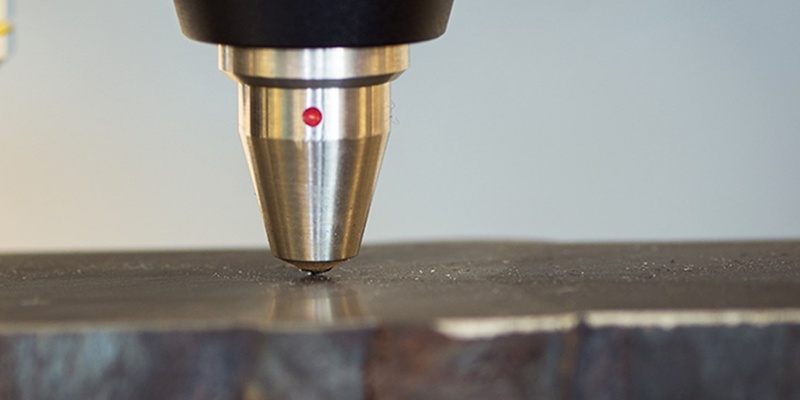- August 25, 2023
The growing research in materials is a major contributing factor to the rise of modern manufacturing. In CNC machining, the variety of machinable materials is also on the rise, and it is beneficial to have a basic understanding of core properties and differences to make the best use of the latest developments.
In this article, we focus on the core material properties of strength, stiffness, and hardness. We will explain each of these in detail and share some professional tips for manufacturing practices.
Strength, Stiffness, Hardness: Why Are They Important?
Material properties are the characteristics of any material that dictate its response (how it changes shape and form) to external forces. It is because of material properties that materials are classified as soft, hard, ductile, conductive, etc.
Strength, stiffness, and hardness are the three most important material properties in the context of materials for CNC machining. They define how materials behave under the action of cutting tools. In fact, it is possible to classify a material as ‘hard to cut’ based on just these three properties.
What is Material Strength?
Strength is arguably the foremost mechanical property for engineering applications. It is the first specification that engineers check when choosing materials for their design. In the simplest sense, it determines how much a material will deform if acted upon by an external force. Hence, the stronger a material, the less it deforms.
To explain this in more detail, we will use the classic stress-strain curve. As you may notice, it contains a lot of information in just one plot. At first, it can be a bit difficult to grasp, but we will break it down into manageable bits and pieces.
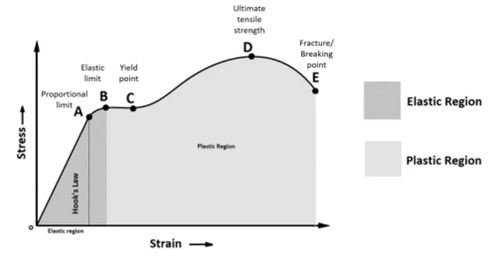
Firstly, let us briefly introduce the concepts of stress and strain, the qualities that the axes of the plot represent.
Stress is the force per unit area. So, the higher the force on the material, the greater the stress. Strain, on the other hand, is the deformation of the material per unit length. Hence, it is a measure of the response of the material under stress. Naturally, they have a direct relationship: if one increases, the other increases, and vice versa.
It is to be noted that there are numerous types of stresses, based on how the force is applied to an object. In our case, we are considering the tensile stress only as it is the most common type of loading condition in most applications.
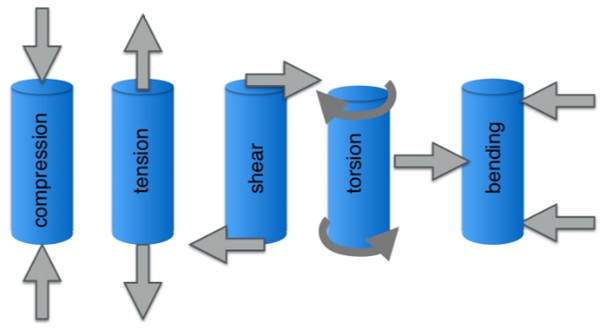
Now, as is visible in the figure, there are points and regions of the stress-strain curve. They represent different kinds of strengths, which are our next topic of discussion.
Yield Strength
The yield strength is the strength of a material before its yielding point. The yield point is a point on the stress-strain curve before which the material deforms elastically. That is, it regains its original shape if the stress is removed. When stressed beyond this point, the material undergoes permanent plastic deformation, which does not go away even if the load is removed.
Understandably, yield strength is the most relevant property for design engineers as plastic deformation is unfavorable for most products.
Ultimate Tensile Strength
The ultimate tensile strength (UTS) is another point on the stress-strain curve that defines the maximum tensile stress a material can achieve. It occurs in the plastic deformation zone and represents the point after which the material starts moving toward failure.
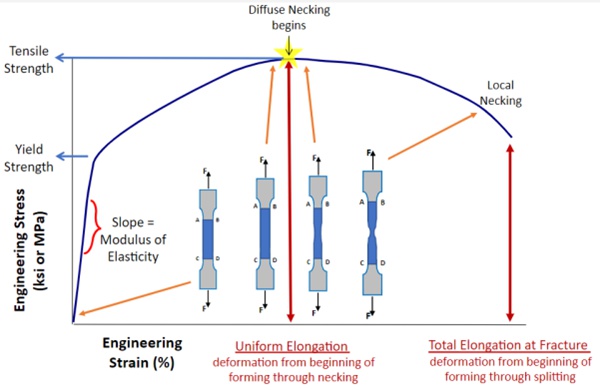
From a design point of view, it is an important measure of stress if the part is expected to deform plastically. Generally, the stress should remain well below the UTS to avoid excessive deformations and fractures.
Fracture Strength
The name fracture strength is self-explanatory. It is the stress value at which a material completely fails and starts breaking apart. That is, it fractures. This is an extreme point of stress and is definitely to be avoided during the design phase.
In the world of machining, a good example would be tool breakage. If a cutting tool is overstressed, its cutting edge chips off, rendering it useless.
Compressive Strength
As explained above, there are various ways to apply stress to a part. The previous discussion was solely based on tensile stresses. Most materials, however, act similarly under other kinds of stress.
Compressive strength is the strength of the material under compression forces. The behavior is the same, the material deforms (initially elastically, then plastically) under compressive loads. Finally, it starts breaking apart at a certain stress value.
Generally, compressive strength is higher than tensile strength as it is harder to compress materials than to elongate them. In engineering design, it is an important feature if the part experiences compressive forces. Some examples of it would be hydraulic presses, columns, and automotive suspension systems.
What is Material Stiffness?
Stiffness is another material property with great relevance to engineering design and manufacturing. Basically, it is a measure of the rate of material deformation under the action of force. Therefore, a material with high stiffness deforms less than a less stiff material.
Referring to the stress-strain curve, stiffness is the ratio between change of stress (force) and strain (deformation). In other words, it is the value of the slope of the stress-strain curve. Thus, the formula for calculating stiffness is:

When the stiffness of only the elastic region is considered, it is also called the ‘modulus of elasticity’. This is a constant value that is true for any point in the elastic deformation zone.
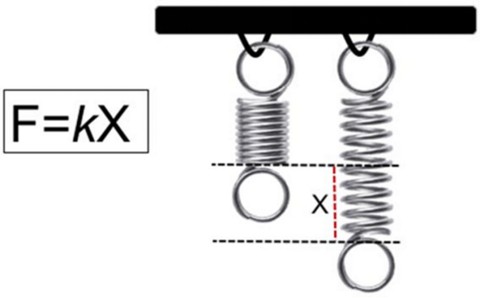
To make the concept of stiffness more understandable for our readers, we can look at Hooke’s Law. It defines stiffness as the ratio between the force applied to a spring versus its extension in response to that force. Hence, k in the figure below is the stiffness.
As can be noticed, the higher the extension of the spring, the less stiff it is. This also conforms to the general understanding of the term ‘stiffness’.
Stiffness in Machining – Cutting Tool Deflection
Let us extend our discussion on stiffness to a real-life example from the world of machining. The cutting tool takes the cutting forces generated by the cutting process and it must be stiff enough to not deform. Small deflections are normal, but excessive deformations can degrade the part’s tolerance and even break the tool.
Consequently, engineers apply their knowledge before tool selection to check whether their tool will deflect within acceptable limits or not. A highly simplified version of this calculation process is provided below.
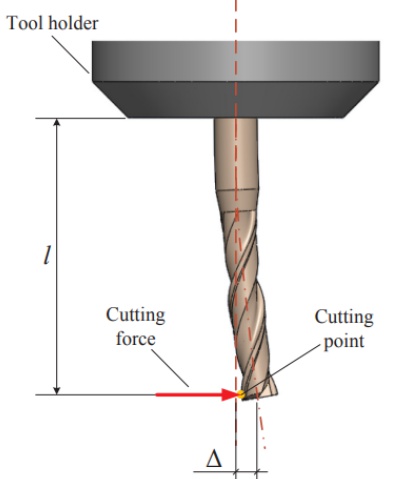
In a machining setup, the tool acts as a cantilever beam. For simplicity, we assume that the cutting force is a point load at the tip of the tool (as the figure shows). Now, for this case, the stiffness of the tool (cantilever beam with a point load) is given by:

Here, E is the modulus of elasticity of the material the tool is made of, I is its moment of inertia, and L is the length of the tool sticking out of the spindle.
Now, since we know the relationship between stiffness, force, and deformation, we can calculate the expected deflection of the tool by using the cutting force, P:

What is Material Hardness?
Hardness is a measure of the resistance of a material against localized permanent deformations. In layman’s terms, it is the resistance of a material against surface deformations like indentation, scratching, and abrasion.
The harder the material, the more difficult it is to scratch. A popular material with high hardness is diamond, which is widely used as a cutting tool.
Hardness is a key material property to consider for engineering decisions. In machining, for example, only hard cutting tools materials like carbide or PCN are compatible with hard-to-cut materials like Titanium. Softer materials like high-speed steel would promptly fail on hard metals.
How is Hardness Measured?
Hardness is one of the most extensively documented material properties. Professionals oftentimes use hardness as a one-off measure of material quality. There are various tests and scales to measure and quantify hardness. We will briefly discuss the main hardness tests and scales.
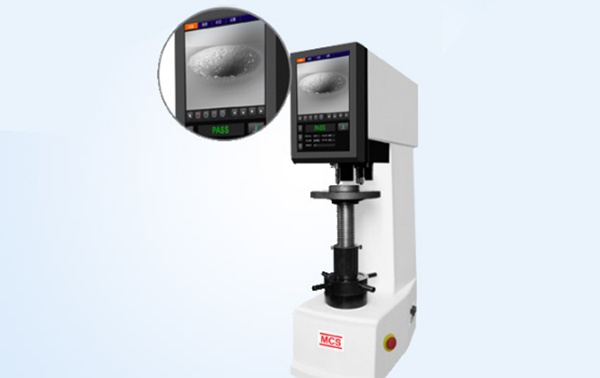
Most hardness tests follow a similar, standardized procedure. An indenter, of a specific shape and material, is pushed into the surface of the test material with a known force. Then, the dimensions of the indentation are noted. Finally, all these values are used to calculate the hardness.
Among tests, the Vickers, Brinell, and Rockwell tests are the most popular ones.
- Vickers Hardness Test: This test uses a pyramid-shaped diamond indenter. Its main applications include thin sections and smaller parts. Therefore, it uses light indentation loads.
- Brinell Hardness Test: The indenter is a 10 mm diameter steel ball. The standard force is 29.42 kN.
- Rockwell Hardness Test: The Rockwell test is highly diverse, with various indenters, loads, and scales. Its load application is also slightly different as it applies a two-step load. First, a minor load, then a major load.
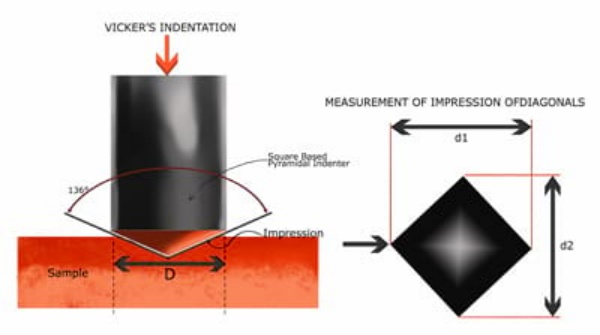
As you may guess, there are numerous hardness scales as well owing to the different hardness tests. Each test has specific applications. For example, the three tests in the previous section are mainly applicable to metals. The Shore hardness scale, on the other hand, is more popular for elastomers and other polymers.
Sometimes, engineers need to convert readings from one scale to another. Conversion charts are an effective method for this, an example of which is below. Thus, it is good practice to have such conversion charts in hand.
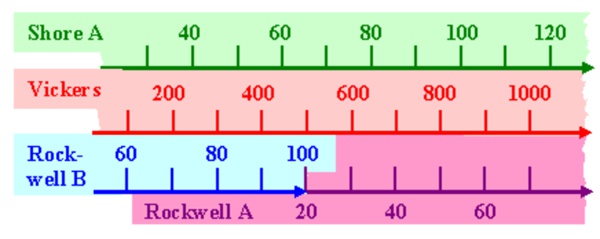
Strength, Stiffness, and Hardness Properties of Common Materials
Material properties can differ drastically from material to material. That is why each material has its specific applications where no other material performs well. Now that we have a basic understanding of strength, stiffness, and hardness, it will be good to see their contrasting values across the material spectrum.
| Material Type | Material | Tensile Yield Strength | Stiffness | Hardness |
| Metal | Titanium(Ti-6AL-4V) | 880 MPa | 113.8 GPa | 334 Brinell |
| Steel(AISI 4140) | 415 MPa | 205 GPa | 197 Brinell | |
| Aluminum(Al 6061-T6) | 276 MPa | 68.9 GPa | 95 Brinell | |
| Bronze(CA 104) | 740 MPa | 115 GPa | 210 Brinell | |
| Composite | Carbon Fiber | 3200 MPa | 234 GPa | 50 HRC |
| Organic | Wood | 120 MPa | 20 MPa | ~1400 (Janka Scale) |
| Inorganic | Glass | 7 MPa | Brittle | 5.5-7 Mohs |
| Diamond | 2800 MPa | 1050 GPa | 10 Mohs | |
| Plastics/ Polymers | Natural Rubber | >27.6 MPa | – | 30-90 Shore A |
| PVC-Multiple Grades (Molded) | 30-50 MPa | Up to 3.25 GPa | 50-99 Shore A | |
| Polyethylene (PET) | 2.69 – 60.7 MPa | 0.483 – 1.75 GPa | 55 – 69 Shore D | |
| ABS | 29.6 – 48 MPa | 1.79 – 3.2 GPa | 100 Shore D |
Strength vs. Stiffness vs. Hardness: What are the Differences?
Strength, stiffness, and hardness are most of the time enough to just the suitability of a material for an engineering application. This is not to say that other material proprietors are in any way unnecessary, but they only become relevant in specific cases.
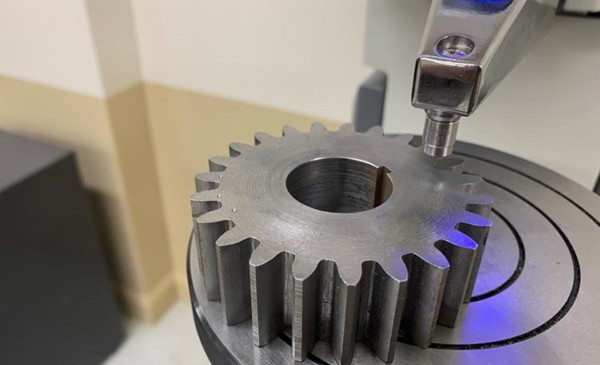
Amongst themselves, these three properties also have certain relationships. For example, tensile strength and hardness are often proven to be directly related. High hardness means high strength in general.
A similar argument applies to the strength vs. stiffness relationship. Strong materials are stiffer mostly. That is why we choose to go with strong materials when we want deformations to be low, as was the case with the cutting tool deflection example above.
However, this is not a hard and fast rule as well. Brittle materials like glass, for example, are stiff but not strong. That is, they do not deform that much under load, but very quickly enter the plastic deformation zone and break.
It is best to evaluate these material properties separately. Usually, underlying relationships like the ones discussed can be directly inferred, but when doing so, engineers should be careful and always double-check the correctness of their assumptions for their specific material choice.
Best Practices for Engineering Design
Engineering design is not an easy game. It takes skill and experience, as well as creativity to design engineering components. Being mindful of material properties is a big part of this process.
In this section, we list down some of the standard engineering practices relevant to material properties that professionals adapt to optimize their designs’ value.
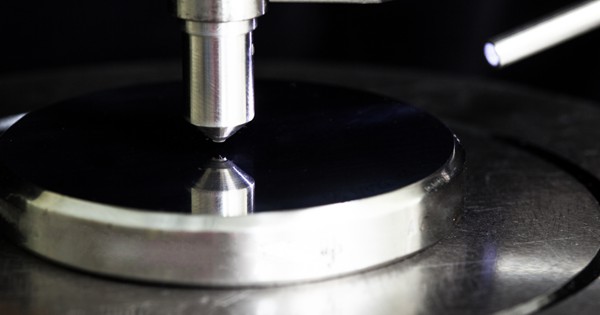
Understand Material Properties
We know that this goes without saying, but it is good to revisit textbook engineering principles and theory from time to time as it can help solidify your basics, coming into handy a great deal during design bottlenecks.
Identify Critical Components and Geometric Features
Each design has certain parts or areas that are more susceptible to failure than others. These can be the main load-bearing components, like the hinges in a door, or they can be specific features like sharp corners with high-stress concentrations. Identifying them beforehand can allow designers to dedicate extra focus to them.
Factor of Safety
It is common practice to use a factor of safety while designing parts. That is, making the part such that it can take loads higher than their load ratings. For example, a pulley may be rated for a load of 1 ton, but it will be designed to fail at 1.5 tons. The safety factor is 1.5 in this case. This is a precautionary measure to account for unexpected overloading conditions.
Avoid Sharp Corners
Sharp corners are often the points of stress concentrations. Thus, it is recommended to use fillets or chamfers at corners. Material choice matters in this case. Hard and strong materials can take higher stresses and may not need large fillets. Softer materials, on the other hand, will require a proper filleting scheme to avoid problems.
Account for Temperature
Temperature causes material properties to change and undergo thermal expansion/contraction. Plastics, for example, become extremely soft at high temperatures. Therefore, high-temperature applications are almost completely dominated by metals and composites.
Consider Dynamic Loads
Dynamic loads are those forces that change with time. Different materials have different resistance against such loading conditions. Some fail very quickly while others can survive millions of cycles of dynamic load variations.
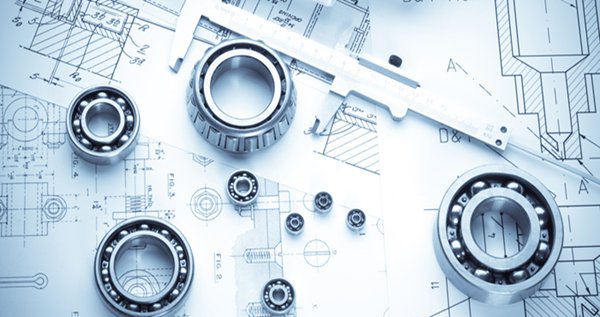
Conclusion
In machining and design engineering, the fundamental principles of material properties play a vital role in shaping the performance, reliability, and safety of various products and structures. Strength, stiffness, and hardness are the chief characteristics to consider when designing load-bearing components and selecting materials.
WayKen is an industrial leader in the rapid manufacturing industry. We offer over 60 metal and plastic materials, helping choose the best-suited material for your projects to achieve optimal performance. Our manufacturing capabilities, including CNC machining, 3D printing, rapid tooling, and vacuum casting are compatible with the strength, stiffness, and hardness of various materials.
FAQs
Which is more important: strength, stiffness, or hardness?
While each of these properties is important, the application dictates which of these the designer should be more focused on. For example, strength is arguably the most important for an automotive chassis as its main function is bearing load.
How to find the material properties of a material?
Organizations such as ASTM have standards for material properties for various material types and grades. The material properties can be found in their publications. Moreover, most material supplies also provide a specifications sheet for their specific brand/batch of materials.
Does temperature change material properties?
Material properties are temperature dependent. Generally, strength, stiffness, and hardness all decrease as the temperature rises, and vice versa.

